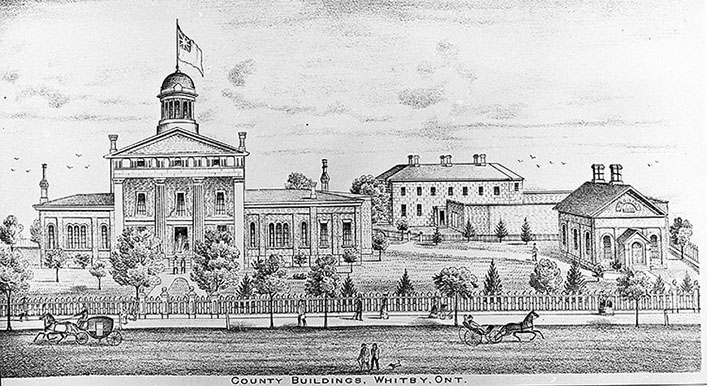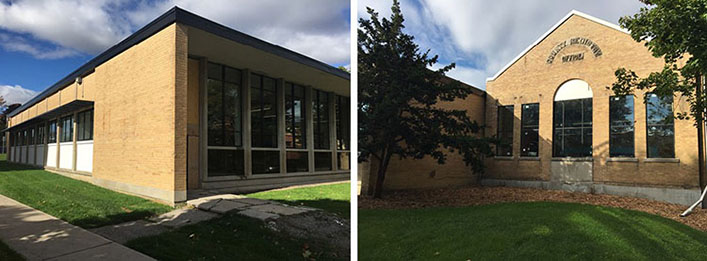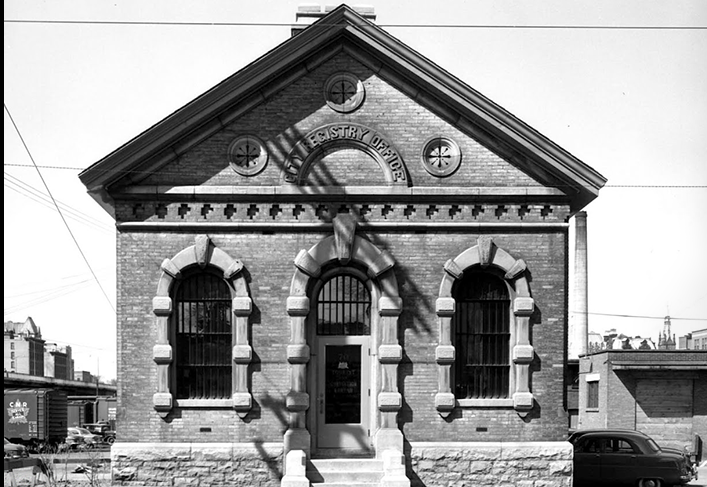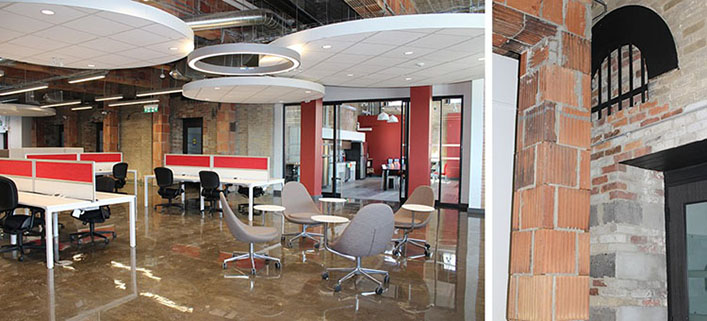Location: Whitby
Date of Completion: 1873; additions made in 1929 and 1953-54
Architect: Kivas Tully (1873, original structure); Rounthwaite and Fairfield (1953-54, addition)
Date of Renovation: 2019
Architect of Renovation: Steven Burgess Architects Ltd.
Nominated by: Lorne Coe, MPP (Whitby)
“Old ideas can sometimes use new buildings. New ideas must use old buildings.”
-Jane Jacobs
Occupying the complex of the former County Registry Office, 1855 BDO Whitby Accelerator establishes an incubator and innovation hub that looks to the future within a building and site deeply tied to the town’s history and the emergence of province-wide architectural standards.
A layered history
Located within a historic city block designed to be the administrative and judiciary heart of Whitby, the accelerator occupies a building complex that once housed the County Registry Office, directly adjacent to the former courthouse and the now-demolished jail. The oldest portion of the complex dates back to 1873, and much of the exterior of this neoclassical structure remains fairly untouched (though the projecting portico was unfortunately demolished in 1929).

1877 print from the Illustrated Historical Atlas of the Ontario County Courthouse and other County buildings featuring Whitby’s administrative block. At left is the Courthouse with the 1866 addition. At centre is the County Jail, constructed in 1853 and demolished in 1960. The Registry Office, built in 1873, can be seen at right. Photo courtesy of the Whitby Archives
As decades passed and the needs for the town grew, new additions were completed with the first one dating to the late 1920s and a second, more robust addition in the 1950s. While the first enlargement built by contractors Herbert Luther Pringle and John F. Schoot was mostly guided by the aesthetic language of the original building, the second addition is a bold modernist pavilion that contrasts and complements the late 1800s structure. Whereas the original building is characterized by solid thick walls, rounded arches and a pitched roof, its modernist add-on features plenty of windows and transparent elevations, a simple flat roof, and strong horizontal lines.
Despite their differences, both buildings share an elegant and restrained design and feature buff brick and limestone details, tying together two different eras in architectural history. Each speaks to its time and to each other, a successful blending of old and new.

The original Land Registry Office building (left) shares a common material language with its modernist wing (right). Photos courtesy of the Town of Whitby
Provincial Architect
The front facade of Whitby’s old registry office might seem familiar to residents of the town of L’Orignal in eastern Ontario, or even St. Thomas, just north of the shores of Lake Erie. In each of these towns, there is a similar structure with the words “County Registry Office” adorning the pediment of its street-facing facade, featuring semi-circular lettering noting the building’s role. These similarities are not a coincidence but are instead a purposeful decision by their shared architect, Kivas Tully.
As the government’s first appointed Ontario Provincial Architect (1868-1896), Tully oversaw the building and design of many prominent institutional buildings across the province, including courthouses, colleges, asylums, and, of course, land registry offices. While diverse in their locations, Tully’s land registry offices were all constructed based on the same architectural drawings and completed within a very short time period (1869-1874). While plans were mostly identical, the different labourers had the choice to use local materials for some components of the building. The result is a series of consistent government buildings across the province that share some clear commonalities, but each displays its own local flair and attributes.

Ottawa’s City Registry Office, one of the many Registry Offices designed by Kivas Tully using a standardized set of plans and features. Photo Credit: City of Ottawa Archives CA-004309
Fireproofing and security
An important repository for the County’s records, fireproofing and security were top of mind when designing the Land Registry Offices. Careful consideration was made to include non-combustible materials as much as possible, with the inclusion of iron doors and surrounds for window fittings, the use of shutters, as well as other elements such as a slate roof. The space was meant to be open and bright, with barrel-vaulted ceilings used to define the different rooms.

The various materials that are a testament to the building’s history of expansion are on full display in the new workspaces (left), and original building characteristics (such as the round-headed windows and iron bars) have been thoughtfully highlighted (right). Photos courtesy of the Town of Whitby
A new beginning
Most recently, the interiors of the former office were extensively renovated to accommodate its newest tenant, 1855 BDO Whitby Accelerator. Workspaces were reconfigured to bring the office up to contemporary standards, with dropped ceilings and office partitions removed from the modernist wing to provide a large, open-plan office conducive to collaboration and cross-pollination. Structural materials that had been covered are now exposed, and floating acoustic panels have been installed in order to dampen noise within the collaborative workspaces. The barrel-vaulted ceilings of the 19th-century building, one of the hallmarks of Tully’s design, are celebrated in this space for innovation—a nod to the past in a space reconfigured for Whitby’s future.
The OAA would like to thank the Town of Whitby and 1855 BDO Whitby Accelerator for their contributions to making this article possible.
This post forms part of our World Architecture Day Queen’s Park Picks 2020 series in which we asked Ontario’s Members of Provincial Parliament to nominate a prominent building, past or present, in their riding for a chance to learn more about it. Check out the rest of the series to learn more about great buildings across the province!